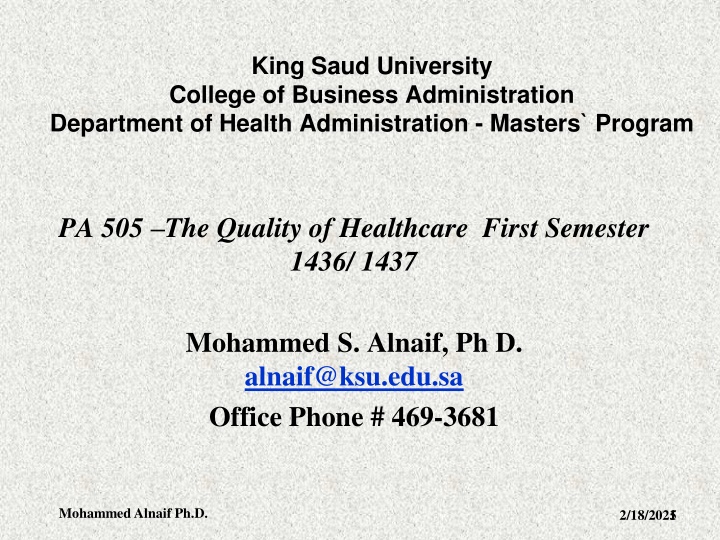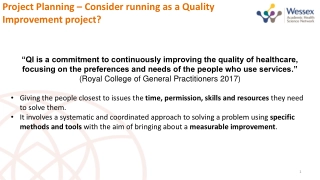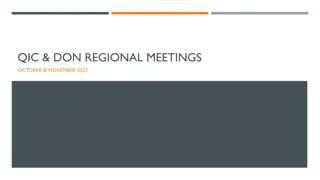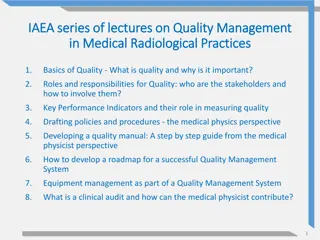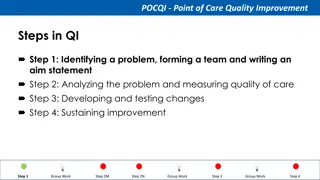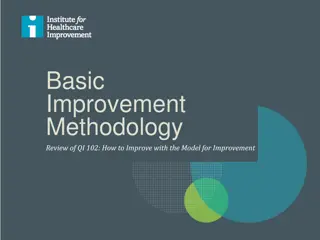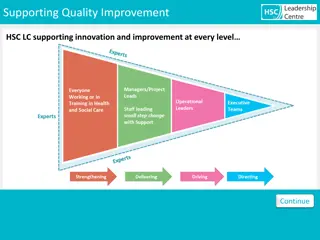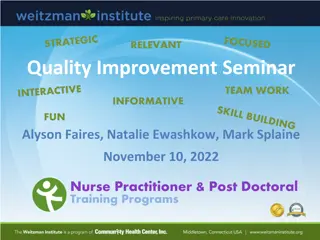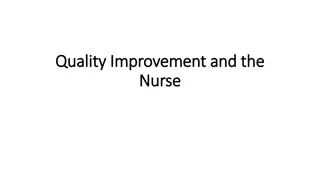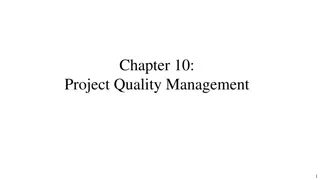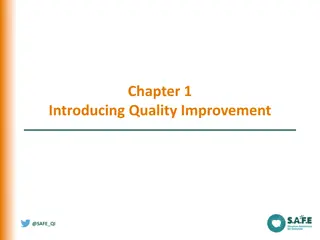Quality Improvement in Healthcare Administration
Performance improvement is a crucial aspect of quality management in healthcare administration. Identifying opportunities for improvement and taking action to address performance issues are essential steps in enhancing the quality of healthcare services. This involves a systematic approach, often requiring in-depth evaluation and the formation of improvement teams. By closely examining factors affecting performance, implementing effective solutions, and continually measuring results, healthcare organizations can achieve significant improvements in quality management.
Download Presentation

Please find below an Image/Link to download the presentation.
The content on the website is provided AS IS for your information and personal use only. It may not be sold, licensed, or shared on other websites without obtaining consent from the author.If you encounter any issues during the download, it is possible that the publisher has removed the file from their server.
You are allowed to download the files provided on this website for personal or commercial use, subject to the condition that they are used lawfully. All files are the property of their respective owners.
The content on the website is provided AS IS for your information and personal use only. It may not be sold, licensed, or shared on other websites without obtaining consent from the author.
E N D
Presentation Transcript
King Saud University College of Business Administration Department of Health Administration - Masters` Program PA 505 The Quality of Healthcare First Semester 1436/ 1437 Mohammed S. Alnaif, Ph D. alnaif@ksu.edu.sa Office Phone # 469-3681 Mohammed Alnaif Ph.D. 2/18/2025 1
Improvement How can we improve performance Quality Improvement Performance improvement is the last phase of quality management. Once an opportunity for improvement has been identified, action must be taken to find and fix the cause of unfavorable performance. Some performance problems can be resolved quickly, such as the two special cause variations in the rejected insurance claims example in Chapter 4. Mohammed Alnaif Ph.D. 2
Improvement How can we improve performance Quality Improvement Performance Improvement Other problems require more in-depth evaluation of the complex factors affecting performance. In these situations, a team is formed to carry out an improvement project. This improvement team is composed of people most familiar with the processes under review. To improve performance, the team must understand the problem and necessary changes. Mohammed Alnaif Ph.D. 3
Improvement How can we improve performance Quality Improvement Performance Improvement During an improvement project, all factors affecting performance are closely examined. Before changing the process, the improvement team must discover where, when, and why problems occur so that effective solutions can be implemented. To do so, the team uses analytic tools to scrutinize the process and select interventions that will produce successful results. Mohammed Alnaif Ph.D. 4
Improvement How can we improve performance Quality Improvement Improvements in Quality Management As shown in Exhibit 5.1, the improvement phase follows performance assessment. Once improvements are implemented, the quality management cycle begins again. The results of process changes are measured and analyzed to determine whether they fixed the performance problem. Mohammed Alnaif Ph.D. 5
The quality management cycle Exhibit 5.1. Cycle of Measurement, Assessment, and Improvement Measurement How are we doing Yes Assessment Are we meeting expectation No Improvement How can we improve performance Mohammed Alnaif Ph.D. 2/18/2025 6
Improvement How can we improve performance Quality Improvement Improvement team A group of individuals organized to work together to accomplish a specific improvement objective. Improvement project An initiative set up to achieve a performance improvement objective within a certain time frame. Analytic tools Qualitative (language) and quantitative (numeric) tools used during an improvement project; often called quality improvement tools. Mohammed Alnaif Ph.D. 2/18/2025 7
Improvement How can we improve performance Quality Improvement LEARNING POINT Improvement Projects Performance improvement projects are initiated when measurement data reveal a gap between expected and actual performance. Projects also may be initiated for other reasons. Improvement project teams include people most familiar with the process under review. Mohammed Alnaif Ph.D. 2/18/2025 8
Improvement How can we improve performance Quality Improvement Performance Improvement Steps Performance improvement projects should be systematic conducted using step- by-step procedures. Without a defined process, chaos is likely to ensue and the improvement team might not achieve desired results. Mohammed Alnaif Ph.D. 2/18/2025 9
Improvement How can we improve performance Quality Improvement Performance Improvement Steps A methodical improvement process has several benefits: Performance problems are permanently solved. Work life quality improves. Performance problems are an annoyance for every- one because they create additional work. People perform better when processes run smoothly. Communication among employees and managers improves. To solve problems, people from different levels of the organization and from different work groups must collaborate. Mohammed Alnaif Ph.D. 2/18/2025 10
Improvement How can we improve performance Quality Improvement LEARNING POINT Improvement Projects Steps Opportunities for better performance trigger improvement projects. A typical project consists of four steps: Define the improvement goal. Analyze current practices. Design and implement improvements. Measure success. Mohammed Alnaif Ph.D. 2/18/2025 11
Quality Improvement Exhibit 5.2. Questions that Help Improvement Teams Maintain Focus STEP 4 How do we measure and track performance? STEP 1 How does the process work now? STEP 2 What can be improved? STEP 3 How do we improve it? Mohammed Alnaif Ph.D. 2/18/2025 12
Improvement How can we improve performance Quality Improvement Performance improvement models Systematic approaches for conducting improvement projects. Over the years, several systematic performance improvement models have been created for use in healthcare and other industries. All these models incorporate similar steps. Mohammed Alnaif Ph.D. 2/18/2025 13
Improvement How can we improve performance Quality Improvement Quality improvement Processes and approaches Form follows function, a concept founded in the field of architecture, describes the importance of understanding what you are trying to accomplish before you determine how you are going to do it. Understanding the purpose behind the effort the goal is important at the individual, departmental, and organizational level when deciding what quality improvement process or approach to adopt. Mohammed Alnaif Ph.D. 14
Improvement How can we improve performance Quality Improvement Quality improvement Processes and approaches The following discussion describes some of the many systems and processes that guide quality improvement efforts today. The following approaches are derivatives and models of the ideas and theories developed by thought leaders in quality improvement. Mohammed Alnaif Ph.D. 15
Improvement How can we improve performance Quality Improvement Quality improvement Processes and approaches Shewhart cycle or PDCA/PDSA cycle Associates in Process Improvement s (API) improvement model Rapid Cycle Improvement FOCUS PDCA model Lean/Toyota Production System Six Sigma Mohammed Alnaif Ph.D. 16
Improvement How can we improve performance Quality Improvement Plan-Do-Study-Act Cycle Walter Shewhart, who developed the concepts and techniques of statistical process control, was one of the first quality experts to discuss a systematic model for continuous improvement. In his book Statistical Method from the Viewpoint of Quality Control, published in 1939, he referred to this model as the Plan-Do-Check-Act (PDCA) cycle. Mohammed Alnaif Ph.D. 2/18/2025 17
Improvement How can we improve performance Quality Improvement Plan-Do-Study-Act Cycle Another renowned statistician, W. Edwards Deming, went to Japan as part of the Allied occupation after World War II to teach the Japanese industrial quality improvement methods, such as statistical process control and systematic process improvement Deming modified Shewhart s original model and renamed it the Plan-Do-Study- Act (PDSA) cycle. Mohammed Alnaif Ph.D. 2/18/2025 18
Quality Improvement Exhibit 5.3. PDSA Cycle of Continuous Improvement Plan-Do-Study-Act Cycle PDSA is the most widely recognized improvement process today (see Exhibit 5.3). To ensure continuous improvement, the steps perpetually cycle and repeat. Do Plan Act Study Mohammed Alnaif Ph.D. 2/18/2025 19
Improvement How can we improve performance Quality Improvement Plan-Do-Study-Act Cycle The following lists summarize the steps of each PDSA phase. Plan State the objectives of the improvement project. Determine needed improvements. Design process changes to achieve the improvement objectives. Develop a plan to carry out the changes (define who, what, when, and where). Identify data that need to be collected to determine whether changes produced desired results. Mohammed Alnaif Ph.D. 2/18/2025 20
Improvement How can we improve performance Quality Improvement Plan-Do-Study-Act Cycle The following lists summarize the steps of each PDSA phase. Do Implement the changes on a small scale. Document problems and unexpected events. Gather data to assess the changes impact on the process. Mohammed Alnaif Ph.D. 2/18/2025 21
Improvement How can we improve performance Quality Improvement Plan-Do-Study-Act Cycle The following lists summarize the steps of each PDSA phase. Study Analyze data to determine whether the changes were effective. Compare results with expectations. Summarize lessons learned during and after implementation of the changes. Mohammed Alnaif Ph.D. 2/18/2025 22
Improvement How can we improve performance Quality Improvement Plan-Do-Study-Act Cycle The following lists summarize the steps of each PDSA phase. Act If changes were not successful, repeat the PDSA cycle. If changes were successful, or partially successful, implement them on a wider scale or modify them as necessary. Predict results. Mohammed Alnaif Ph.D. 2/18/2025 23
Improvement How can we improve performance Quality Improvement Associates in Process Improvement s (API) improvement model Tom Nolan and Lloyd Provost, cofounders of API, developed a simple model for improvement based on Deming s PDSA cycle. Three fundamental questions form the model s basis for improvement (see Exhibit 4.2): 1. What are we trying to accomplish? 2. How will we know that a change is an improvement? 3. What change can we make that will result in improvement? Mohammed Alnaif Ph.D. 2/18/2025 24
Improvement How can we improve performance Quality Improvement Associates in Process Improvement s (API) improvement model The focus on the three questions and the PDSA cycle allows the model s application to be as simple or sophisticated as necessary. The effort required to bring about improvement may vary on the basis of the problem s complexity, whether the focus is on a new or an old design, or the number of people involved in the process. Mohammed Alnaif Ph.D. 2/18/2025 25
EXHIBIT 4.2 API Model for Improvement 1. 2. What are we trying to accomplish? How will we know that a change is an improvement? What change can we make that will result in improvement? 3. Plan Do Study Act Mohammed Alnaif Ph.D. 26
Improvement How can we improve performance Quality Improvement Plan-Do-Study-Act Cycle Rapid Cycle Improvement The PDSA cycle is used in rapid cycle improvement (RCI) projects. Unlike a comprehensive (and often time-consuming) process analysis, an RCI project incorporates several small process changes and careful measurement of those changes to achieve an improvement goal. This approach is an accelerated method (usually less than six weeks per improvement cycle) of collecting and analyzing data and making changes on the basis of that analysis. The first cycle is followed by a second improvement cycle to evaluate the effects of the changes on the process. Mohammed Alnaif Ph.D. 2/18/2025 27
Improvement How can we improve performance Quality Improvement Plan-Do-Study-Act Cycle Rapid Cycle Improvement Suppose an ambulatory clinic wants to improve patient satisfaction by 20 percent during the coming year. An improvement team composed of clinic staff and physicians completes a PDSA cycle for each improvement idea. Some ideas are successful and become office practices. Ideas that fail are discarded. Over a short period, the team completes several PDSA cycles, all linked to the goal of improving patient satisfaction. This RCI process is illustrated in Exhibit 5.5. Mohammed Alnaif Ph.D. 2/18/2025 28
Add a preregistration option to the clinic s website Greet patients within 1 minute of arrival at the clinic P D Increase variety of health education pamphlets S A Patient satisfaction improves by 20 percent P D Add automated appointment reminder system A S P D S A P D Exhibit 5.5. Incremental Patient Satisfaction Improvements Achieved Through Repeated PDSA Cycles A S Hunches, theories, and ideas 29 Mohammed Alnaif Ph.D.
Improvement How can we improve performance Quality Improvement Plan-Do-Study-Act Cycle Rapid Cycle Improvement Note that the four process changes are made in succession. The team completes the PDSA cycle each change before moving on to the next one. Each adjustment brings the clinic closer to its goal. The RCI model is used in many healthcare improvement initiatives. Mohammed Alnaif Ph.D. 2/18/2025 30
Improvement How can we improve performance Quality Improvement FOCUS-PDCA In the early 1990s, Hospital Corporation of America, based in Nashville, Tennessee, expanded Shewhart s PDCA model by adding preliminary steps known as FOCUS The FOCUS-PDCA model of performance improvement involves the following steps. Mohammed Alnaif Ph.D. 2/18/2025 31
Improvement How can we improve performance Quality Improvement FOCUS-PDCA FOCUS phase Find a process that needs improvement. Define the beginning and end of the process, and determine who will benefit from the improvement. Organize a team of people knowledgeable about the process. This team should include employees from various levels of the organization. Clarify the current process and the changes needed to achieve the improvement. Understand the causes of variation by measuring performance at various steps in the process. Select actions needed to improve the process. Mohammed Alnaif Ph.D. 2/18/2025 32
Improvement How can we improve performance Quality Improvement FOCUS-PDCA PDCA phase Plan the change by studying the process, identifying areas needing improvement, and determining ways to measure success. Do the change on a small scale, and gather data to measure success. Check the data to determine whether the change produced the desired improvements. Modify the change if necessary. Act to maintain the gains. Implement the change if it is working well. Abandon the change if it is ineffective, and repeat the PDCA phase. Mohammed Alnaif Ph.D. 2/18/2025 33
Improvement How can we improve performance Quality Improvement FADE The FADE model of performance improvement is an adaptation of the original PDSA/ PDCA improvement cycle. FADE was developed by Organizational Dynamics Inc. (2006), a global management consulting firm that helps all types of organizations improve quality and productivity and enhance customer satisfaction. Mohammed Alnaif Ph.D. 2/18/2025 34
Improvement How can we improve performance Quality Improvement FADE The FADE improvement model consists of four phases: 1. Focus. Choose a problem, and write a statement to describe it. 2. Analyze. Learn more about the problem by gathering performance data. 3. Develop. Develop a solution for the problem and a plan for implementing the solution. 4. Execute. Implement the plan and monitor results. Adjust the plan as needed. Mohammed Alnaif Ph.D. 2/18/2025 35
Improvement How can we improve performance Quality Improvement FADE The FADE model works for all types of performance problems. The FADE model of performance improvement is useful for focusing on a problem, analyzing the problem and its causes, developing and implementing a solution, and monitoring success. Mohammed Alnaif Ph.D. 2/18/2025 36
Improvement How can we improve performance Quality Improvement Lean Some improvement models are intended for specific purposes. One such model is the Lean model of improvement, which is used to eliminate inefficiencies adversely affecting performance. A Lean process includes only value-added steps and therefore produces little waste. Mohammed Alnaif Ph.D. 2/18/2025 37
Improvement How can we improve performance Quality Improvement Lean The Lean model of improvement, also called Lean manufacturing or Lean thinking, originated in the Japanese automobile industry in particular as the Toyota Production System. Lean manufacturing concepts are now used in healthcare to improve efficiency and reduce errors. Mohammed Alnaif Ph.D. 2/18/2025 38
Improvement How can we improve performance Quality Improvement Lean Lean principles are applicable to an array of healthcare processes and work settings, from patient care to medical informatics to plant maintenance. Healthcare organizations eliminate waste and thus improve efficiency and quality by applying the five Lean principles of process improvement. Mohammed Alnaif Ph.D. 2/18/2025 39
Improvement How can we improve performance Quality Improvement Lean The five Lean principles of process improvement: 1. Value, identify what is important to the customer and focus on it. 2. Value stream, Ensure all activities are necessary and add value. 3. Flow, strive for continuous processing through the value stream. 4. Pull, Drive production with demand. 5. Perfection, Prevent defects and rework. Mohammed Alnaif Ph.D. 2/18/2025 40
Improvement How can we improve performance Quality Improvement Lean Lean relies on various methods and tools, including problem-solving diagrams and statistical techniques, to find waste Common sources of waste are processing, correction, overproduction, motion, material movement, waiting, and inventory Mohammed Alnaif Ph.D. 2/18/2025 41
Improvement How can we improve performance Quality Improvement Muda/ Lean The Japanese term for waste, a concept taken from Lean manufacturing, (Muda is anything that does not add value to the customer. Although some Muda is inevitable, the goal of a Lean project is to reduce it as much as possible.) The goal of any Lean project is to create a more efficient process than is currently in place. Except for the application of Lean principles, Lean projects follow steps similar to those of other improvement projects: Mohammed Alnaif Ph.D. 2/18/2025 42
Improvement How can we improve performance Quality Improvement Muda/ Lean Lean projects follow steps similar to those of other improvement projects: 1. The performance problem is stated from the process customer s viewpoint. For instance, radiology technicians are physicians customers. If a Lean project is initiated for the process of completing X-ray exams, the performance problem from the technician s perspective might be X-ray exams are delayed when ill- defined physician orders must be clarified. Mohammed Alnaif Ph.D. 2/18/2025 43
Improvement How can we improve performance Quality Improvement Muda/ Lean Lean projects follow steps similar to those of other improvement projects: 2. Current work procedures are examined, and a diagram of the current process is created. The illustration of the current process is based on what is happening in the present, not recollections of what happened in the past or what should be happening. Direct observation is the preferred way to gather this information. The process diagram clarifies the cause of the performance problem. Mohammed Alnaif Ph.D. 2/18/2025 44
Improvement How can we improve performance Quality Improvement Muda/ Lean Process diagram, is a visual representation of the flow of individual steps or activities in a process also known as process flowchart or process mapping. 3. Improvement opportunities are identified and quantified. Data are gathered to determine the frequency of the problem and the problem s impact on process customers. Mohammed Alnaif Ph.D. 2/18/2025 45
AHRQ Mohammed Alnaif Ph.D. 46
Improvement How can we improve performance Quality Improvement Muda/ Lean 4. Root causes of the problem are investigated. A common approach to get to the root of the problem is to ask, five times in a series, why the problem occurs (The Five Whys performance improvement tool is discussed later). 5. A better way to work is proposed and illustrated in a process diagram. This better way is designed to alleviate the root causes identified in the previous step. Mohammed Alnaif Ph.D. 2/18/2025 47
Improvement How can we improve performance Quality Improvement Muda/ Lean 6. An implementation plan is developed. The plan identifies the actions needed to realize the process changes and assigns plan implementation responsibilities. A deadline for completion is set. 7. A follow-up plan is created. This plan predicts performance improvements expected to result from the implemented changes. The expected improvements are defined in measurable terms, and the means of gathering measurement data are specified. Mohammed Alnaif Ph.D. 2/18/2025 48
Improvement How can we improve performance Quality Improvement Muda/ Lean 8. After process changes are made, results are compared with the projections made in step 7. A growing number of cost-conscious healthcare organizations are conducting Lean projects to improve daily operations. When these projects are successful, the organizations achieve more with less: They care for more patients with the same number of staff in the same (or less) space at reduced costs.Exhibit 5.6 shows Eight Categories and Examples of Waste (Muda) Mohammed Alnaif Ph.D. 2/18/2025 49
Exhibit 5.6 Eight Categories and Examples of Waste (Muda) Waste Category Example Unnecessary human movement (e.g., staff walking to various places around the work area to obtain supplies) Movement People waiting for something needed to do their work (e.g., a radiologist waiting for a patient to be brought into the exam room) Waiting Doing more than is necessary to meet requirements (e.g., doing two blood tests on a patient when one would have been sufficient) Over processing Poor quality work and rework to fix mistakes (e.g., rebilling the insurance company because the first bill contained an error) Defects Mohammed Alnaif Ph.D. 50
